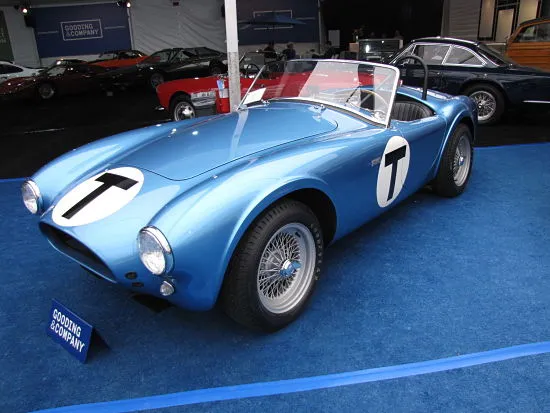AC Tyres
Classic AC Tyres
On the following pages, Longstone Classic Tyres give classic tyre fitment recommendations for AC cars.
- AC Ace: We recommend 5.50 R 16 Michelin X.
- AC Cobra: We recommend 185 VR 15 PIRELLI CINTURATO CA67 or a selection of Avon CR6ZZ tyres.
- AC 428: We recommend 205 VR 15 PIRELLI CINTURATO CN72.
01302 711 123
or
Email: sales@longstonetyres.co.uk
AC
AC Cars, formerly known as Auto Carriers Ltd., is a British specialised automotive manufacturer and one of the country's oldest independent car manufacturers. Due to poor financial situations throughout the years, the corporation was renamed or dissolved several times before taking its current form.
The first automobile from what would ultimately become AC was shown at the Crystal Palace motor exhibition in 1903; it was a 20 HP touring car and was known as the Weller. The Weller Brothers of West Norwood, London, intended to build a high-performance 20-horsepower automobile. However, their financial supporter and company manager, John Portwine, decided the automobile would be too expensive to construct and persuaded Weller to design and produce a small delivery three-wheeler instead.

In 1904, a new firm called Autocars and Accessories was created, and manufacturing began with the Auto-Carrier. The car rapidly became popular and was a financial success. Three years later, the A.C. Sociable, a passenger variant, was released. In place of the cargo box, it had a seat, the luxury!
In 1911, the firm changed its name to Auto Carriers Ltd. and relocated to Ferry Works in Thames Ditton, Surrey; around this time, they also began utilising the famous "AC" roundel emblem, continuing to manufacture commercial three-wheeled tricars. In 1913, they created their first four-wheeled vehicle, a speedy two-seater with a transmission on the back axle. Only a handful were manufactured before the First World War halted manufacturing. During WWI, the Ferry Works facility manufactured shells and fuses for the war, while at least one vehicle was planned and built for the War Office.
At the end of the war, Auto Carriers resumed production of motor vehicles, developing and producing numerous successful automobiles. Soon after, John Weller began work on a new overhead-cam six-cylinder engine. By 1919, the first variations of this design were in use. The Weller engine was manufactured until 1963.

Selwyn Edge (formerly with Napier) purchased shares in the firm in 1921 and was later named controlling director. He didn't get along with Weller or Portwine, both of whom left less than a year later. Edge, as is common, sought notoriety for the firm through motoring competition. In 1922, the name was changed once more to AC Cars Ltd. Selwyn Edge purchased the firm fully for £135,000 in 1927 and re-registered it as AC (Acedes) Ltd, but sales continued to plummet. The firm was swept up in the 1929 financial crisis and went into voluntary liquidation. In 1930, William and Charles Hurlock purchased AC, not for the purpose of manufacturing automobiles, but for its service company and factory. However, William Hurlock desired a new car and utilised components from the AC archive to make his own.
1953 saw the launch of the AC ace, a revolutionary car in both design and styling. The ace would go on to form the blueprint for successful AC cars in future years such as the Aceca, the 3000ME and the Cobra! In 1952, John Tojeiro's sports racing vehicle served as the inspiration for the alloy-bodied Ace, which was unveiled in 1953 with gently updated styling and the Weller engine. This was eventually followed by the Aceca and Greyhound, with Bristol and Ford motors as options in 1956 and 1961, respectively. The Ace was very effective in competition and was utilised by several racing drivers at the start of their careers.
The Cobra derivative of the Ace was introduced in 1962, and in 4.7 and 7-litre variants, it dominated the global competition, winning the World SportsCar Championship in 1965. The Cobra was retired in 1968, and in its place was offered the 7-litre, 140-mph Frua 428. The prototype 3000ME debuted at the 1973 Earls Court Motor Show, featuring a Ford V6 engine and fibreglass bodywork. Production began in 1978 and lasted until 1985.
After 56 years of ownership, the Hurlock family sold the firm in 1986, with ownership finally moving to a combination of Autokraft Ltd and the Ford Motor Company. AC Cars relocated to a new purpose-built plant inside the Brooklands racing circuit in 1988, and in 1992, Brian Angliss of Autokraft purchased Ford's stake and seized full control. From 1985 until 1990, the redesigned Cobra in Mark IV form was the primary product, but in 1990, a new Ace was created, which went into production in 1993 with North American and EEC certification.
Alan Lubinsky purchased AC Cars in 1997, and the development of the new AC Brooklands Ace, Aceca, Superblower, and Carbon Road Series (CRS) Cobra has proceeded under the AC Car Group banner, still at the Brooklands Factory in Weybridge, Surrey. In 2001, this plant was sold, and a smaller business was established at a site in Frimley. This most recent location focused on repairs, restorations, and the construction of the MkII and MkIII 289 and 427 FIA Roadsters. The Frimley plant closed in October 2004 and relocated to Guildford, then to Hal Far in Malta in 2005. The Malta factory shut down in 2008.



